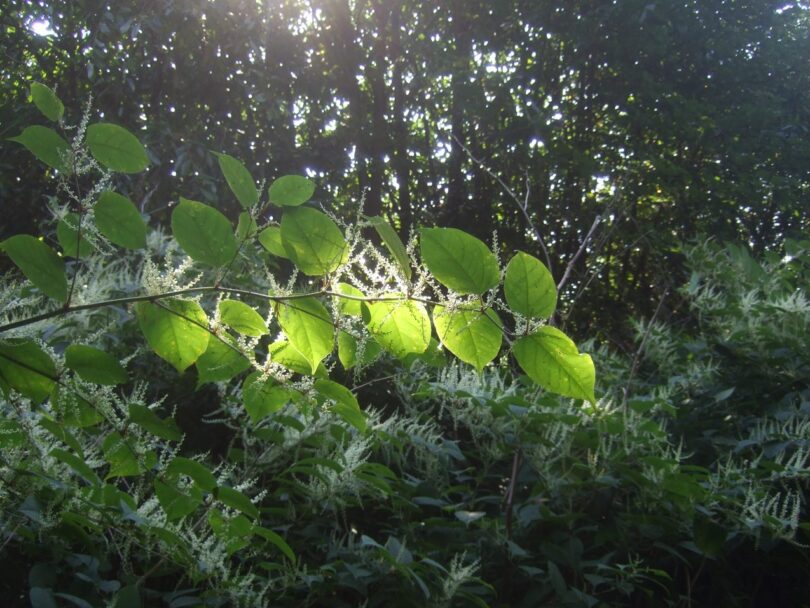Can you Remove Japanese knotweed Yourself?
08-12-2022
Last updated 10-07-2024

It is possible to attempt to remove Japanese knotweed yourself, but it is not recommended as only professionals will have the required skills and previous experience in removing knotweed. Japanese knotweed is a highly invasive plant and the process can be complex and time-consuming and should be carried out by accredited Japanese knotweed specialists with experience in Japanese knotweed removal.
Attempting to treat Japanese knotweed yourself by cutting or pulling it out of the ground can stimulate growth, generate propagules and lead to further infestation and spreading. Knotweed can grow up to 10cm a day during spring and summer, which means that you risk exacerbating the situation. This could also lead to various legal issues, including prosecution or litigation if the infestation spreads onto neighbours’ property.
If you do attempt to remove Japanese knotweed yourself, you should also consider that it is your responsibility to prevent the spread of knotweed in the wild. Japanese knotweed can be spread into the wild via contaminated soil or waste when disposing of plant clippings.
Knotweed is highly resilient and often requires several rounds of specialist treatment to prevent its return; it can also survive in conditions that are unfavourable for most other plant species. When disposing of knotweed, you should ensure that it is disposed of at an appropriately licensed waste facility.
Due to the complexities of its removal and disposal, we highly recommend seeking the advice of an appropriately accredited Japanese knotweed removal specialist.
Keeping reading to learn more about removing Japanese knotweed safely to minimise risk. If you think you have knotweed on your property, we offer a free Japanese knotweed identification service; if you have a confirmed knotweed infestation, book your Japanese knotweed survey now.
Contents
- How do professionals remove Japanese knotweed?
- How long does it take to get rid of Japanese knotweed?
- Can Japanese knotweed be removed permanently?
- Why should you not cut Japanese knotweed?
- Does Roundup work on Japanese knotweed?
- How do you get rid of Japanese knotweed naturally?
- Can Japanese knotweed grow through concrete?
- How deep do Japanese knotweed roots go?
- Will the council remove Japanese knotweed?
- Is knotweed covered by insurance?
- How much does it cost to remove Japanese knotweed in the UK?
- Why is it so hard to get rid of Japanese knotweed?
- Should I dig up Japanese knotweed?
- How do I get rid of Japanese knotweed?
How do professionals remove Japanese knotweed?
Japanese knotweed removal contractors will use one of the following methods to remove Japanese knotweed from domestic or commercial premises.
Excavation and removal to landfill
This treatment ensures that the underground root and rhizome systems are removed and professionally disposed of in a suitably licensed disposal site to provide complete and long-term eradication.
Herbicide treatments
This is a cheaper option for removal but can take several seasons to achieve complete control and can lead to the plant becoming dormant rather than removing it entirely.
How long does it take to get rid of Japanese knotweed?
The time it takes to remove Japanese knotweed depends on the treatment used to control it, with the more costly treatments removing knotweed in the shortest time possible.
Chemical treatment typically takes 24-48 months for removal, with herbicides used over 2 to 4 growing seasons. Japanese knotweed removal specialists can use techniques to speed up the process to reduce the vigour of the rhizomes.
There has been an increase in companies offering to remove knotweed in a single growing season using herbicides. Various professional bodies and regulators have highlighted that no product or chemical solution will remove mature knotweed in a single season.
If knotweed is located where it is preventing building works or other activities from taking place, it doesn’t necessarily need to be dug up and thrown away in a landfill. Excavated knotweed fragments and knotweed-bound soil can be relocated to a more convenient location of the site for treatment with herbicides. This doesn’t reduce the time it takes for the herbicide treatment to work, but it does free up space so that knotweed affected ground can be built upon more or less immediately.
Another way to treat knotweed that has been removed from an area where it is in the way of construction or other works is to bury the excavated material. However, the burial pit needs to be sufficiently deep to prevent the knotweed from regrowing aboveground. The burial pit also needs to be in an area where the overlying ground will not be disturbed. On development sites this can be areas planned for car parking or public open spaces.
In order to save disposal costs, the waste material arising from knotweed excavation can be reduced in a number of ways. There are various methods allow reduced excavations to take place and for root barrier membranes to be installed to section off live rhizomes so that they can be left in the ground where they won’t affect building or landscaping works.
Another common method to reduce disposal costs is to screen the knotweed excavated soil in machinery or to pick and sort it so that soil and rhizome fragments are separated.
Can Japanese knotweed be removed permanently?
Yes, it is possible to remove Japanese knotweed permanently, but you should always consult the services of a suitably qualified and accredited professional. You should also be aware that opting for the cheaper herbicide methods of treating knotweed will require longer to complete and pose risks of the infestation returning.
For the most comprehensive control, we recommend opting for the following removal methods:
- Excavation and removal to landfill
- Reduced level excavation and in-situ root barrier capping
- Digging and sifting of excavated contaminated waste
- Relocation and herbicide treatment of excavated material
- Burying excavated material on-site in a burial cell
Why should you not cut Japanese knotweed?
You should not cut, strim or mow Japanese knotweed, as this can stimulate growth. It also increases the likelihood of Japanese knotweed spreading, which can lead to legal issues and prosecution for failing to control the infestation. Your clothing and shoes can also spread Japanese knotweed if you come into contact with it when attempting removal.
Does Roundup work on Japanese knotweed?
Roundup is a glyphosate-based herbicide that can control the spread of Japanese knotweed infestations on domestic and commercial premises; however, it will often not entirely eradicate Japanese knotweed.
For thorough Japanese knotweed removal and to avoid legal consequences, you should seek the services of knotweed removal specialists who have access to professional herbicide products and who can advise on alternative treatment methods to remove knotweed quickly and thoroughly.
How do you get rid of Japanese knotweed naturally?
If you don’t want to use herbicides then you can get rid of Japanese knotweed naturally by digging it up and disposing of the rhizomes. Some people have tried burning it, but this is rarely effective and fresh rhizomes and rhizome-bound soil are not easily combustible. As with all methods of eradicating knotweed, attempting to remove knotweed organically without engaging with a specialist in knotweed removal poses drawbacks and potential legal consequences if knotweed spreads.
Can Japanese knotweed grow through concrete?
Japanese knotweed cannot grow through concrete or brick. Reports and misinformation in the media have led people to believe the contrary. What Japanese knotweed can do, however, is exploit and grow through cracks in built structures as its rhizomes and roots grow and seek out moisture. This can cause extensive structural damage as the rhizomes and crowns expand, damaging the hard surfaces like brick and concrete that surround them.
How deep do Japanese knotweed roots go?
Japanese knotweed roots can burrow up to 3 metres beneath the ground, with some large rhizome reaching up to 20cm in thickness. Knotweed can develop an impressive ‘iceberg’ of underground rhizomes, connected to mounds or rooty material above the ground called crowns from which clumps of stems emerge. The iceberg or rhizomes and root lives on in the dormant winter months when the aboveground stems and leaves die back, only to emerge as new growth each spring.
Will the council remove Japanese knotweed?
The council will not remove Japanese knotweed from private property; you will be held responsible for its removal and ensuring it does not spread to surrounding land. Due to the complexities surrounding knotweed, you should ensure that specialists manage the infestation removal. If you spot Japanese knotweed on council-owned land, contact your local council to report the infestation so they can arrange its removal.
Is knotweed covered by insurance?
In most cases, insurers will not pay out for Japanese knotweed claims and having it on your land should not affect your home insurance premiums. However, you will be expected to ensure that the Japanese knotweed is under control to protect your home and prevent it from spreading to nearby properties. You will also need to declare the presence of knotweed and prove that it is being treated professionally in order to comply with the requirements of the TA6 Property Information Form when selling your house. Therefore, removing knotweed is always the best course of action to avoid damage to buildings and possible criminal prosecution.
How much does it cost to remove Japanese knotweed in the UK?
The cost of removing Japanese knotweed in the UK depends on the required treatment method and can range from several thousand pounds to hundreds of thousands. Knotweed removal on domestic premises ranges from £2,000 – £5,000 for herbicide treatment and around £10,000 for excavation; removal on construction or building sites where the infestation may be more extensive will typically start at around £15,000.
Why is it so hard to get rid of Japanese knotweed?
Getting rid of Japanese knotweed is challenging due to its substantial rhizome system that can penetrate deep into the ground. This makes it removal challenging without an accredited specialist’s help. Undertaking the work yourself or using an unqualified individual or firm could lead to the significant devaluation of your property. It could also lead to potential prosecution or litigation if your actions cause the knotweed to spread.
Should I dig up Japanese knotweed?
You should only dig up an infestation of Japanese knotweed if you have previous experience in doing so in a professional capacity. If not done correctly, you risk spreading the Japanese knotweed to the surrounding area, which can have costly legal consequences. Once dug up, you also need to dispose of it in accordance with relevant laws and regulations.
How do I get rid of Japanese knotweed?
If you have identified Japanese knotweed on a building site or property, you should engage with a suitably accredited Japanese knotweed specialist to conduct an in-depth knotweed survey and to advise on the best treatment programme for complete control.



